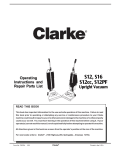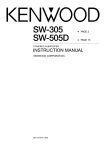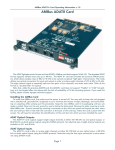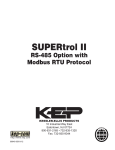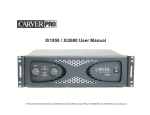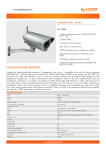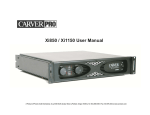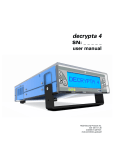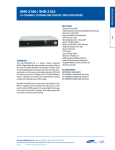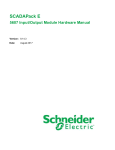Download here - Sonorus Audio
Transcript
SonoruS Audio ATR10 Analog Tape Reproducer Operating Manual 1 OPERATING INSTRUCTIONS FOR THE SonoruS ATR10 IMPORTANT NOTES Protect your tape deck from excessive heat and humidity. Install it in a manner which ensures the free convection of air through the ventilation louvers. There are no user serviceable parts inside the machine. It should therefore only be opened by qualified service personnel. The ATR10 is configured in the factory for use with a single AC line voltage. Check the voltage rating on the rear connector panel to ensure it is configured for the correct AC line voltage. Applying the wrong AC line voltage increases the risk of fire and can cause permanent damage to the ATR10. North America: Europe: Japan: Other areas: 120VAC 230VAC 100VAC Contact SonoruS Audio LLC to check for compatibility. WARRANTY The ATR10 is covered by a one year limited warranty on parts and labor from the day of delivery. Excessive wear and tear is not covered. 2 TABLE OF CONTENT INTRODUCTION 4 SUMMARY OF FEATURES 4 SUMMARY OF OPERATING CONTROLS 5 CONNECTIONS 7 DETAILED EXPLANATION OF FUNCTIONS 9 QUICK REFERENCE OPERATING INSTRUCTIONS 13 WIRELESS REMOTE CONTROL 15 TECHNICAL SPECIFICATIONS 16 3 INTRODUCTION The SonoruS Audio ATR10 Analog Tape Reproducer is a newly designed tape playback machine that meets the highest demands of the music and audio devotee. The ATR10 combines the proven performance and reliability of Studer/ReVox mechanical parts with brand new electronics, designed to meet the highest performance expectations of modern High End audio equipment. Regulated tape tension and strategically placed rolling tape guides provide the same stable tape transport as professional studio tape machines, while carefully designed vacuum tube based playback electronics result in an unprecedented dynamic range combined with the total absence of any type of electronic coloration of the sound. The result is a playback system that coupled with the finest quality source material available today, is capable of providing a level of realism that gives the listener the sense of being present at the live music performance in it's original venue. SUMMARY OF FEATURES • Compact single box Plug and Play solution • Built-in Vacuum Tube playback electronics • Stable performance for years to come due to automatic tube set point adjustment • Wireless Remote control • Newly designed tape drive electronics • Regulated tape tension • Tape standard: 1/4” 2 track • Selectable tape speeds: 7.5 and 15ips • Selectable EQ: NAB and IEC • Self centering NAB spindles • Library Wind 4 SUMMARY OF OPERATING CONTROLS TAPE TRANSPORT 1 2 3 4 6 5 7 8 9 10 11 13 12 15 14 16 AUDIO 20 21 17 23 24 18 19 22 5 TAPE TRANSPORT 1. Tape counter 2. Reset button for tape counter 3. Supply reel tape tension arm 4. Take-up reel tape tension arm 5. Edit slide 6. REEL SIZE selector button for small reels 7. TAPE DUMP button for dump editing 8. Tape speed selector buttons 9. AC POWER switch 10. Fast Braking button 11. << Slow rewind key (Library wind) 12. <<< Fast rewind key 13. >>> Fast forward key 14. PLAY key 15. STOP key 16. >> Slow forward key (Library wind) AUDIO 17. Headphones level control 18. Headphones output 19. Audio electronics warm-up indicator 20. NAB Playback equalization button 21. IEC / CCIR Playback equalization button 22. Audio output muting override button 23. Left channel level meter 24. Right channel level meter 6 CONNECTIONS REAR PANEL 25 TOP PANEL 26 27 29 28 30 HEAD BLOCK 3 4 31 32 41 33 34 5 35 36 37 38 39 40 7 CONNECTIONS REAR PANEL 25. Right channel RCA output connector 26. Left channel RCA output connector 27. AC Power inlet connector 28. Fuse holder TOP PANEL 29. Right channel XLR output connector 30. Left channel XLR output connector HEAD BLOCK 31. Supply reel tape guide 32. Take-up reel tape guide 33. Optical tape-end sensor 34. Erase head (not used, but installed for correct tape flow) 35. Tape lifter 36. Center tape guide / scrape roller 37. Playback head 38. Tape lifter 39. Capstan shaft 40. Pinch roller 41. Leader tape sensor (optional) 8 DETAILED EXPLANATION OF FUNCTIONS TAPE TRANSPORT FUNCTIONS Tape counter (1) The tape counter is driven by the take up reel motor. The counter therefore gives an indication of the position on the tape, but is not linearly related to the position on the tape. The tape counter does not have a direct relation to the elapsed time. Tape counter reset button (2) The reset button puts the counter to 0000. This can be done at the beginning of the tape or at any other place on the tape to serve as a locator point. Tape tension arms (3) (4) These arms are intended to keep the tape under some tension when the tape starts playing. The ATR10 has electronically regulated tape tension on both sides, however these tape tension arms are not involved in that process. Edit slide (5) When operating this slide, the tape will be pressed against the sound heads. Thus, the cutting position can be searched by manually turning the reels. This function can be cancelled by pressing the PLAY key (14) or by lightly pushing the pressure roller against the capstan. REEL SIZE button (6) When using small-diameter tape reels ( 7” (18 cm) or smaller) the REEL SIZE button (10) should be pressed down. (Since the ATR10 has electronically regulated tape tension on both sides the REEL SIZE button does not impact the tape tension. Instead it increases the Library wind speed and disables the FAST BRAKE key.) TAPE DUMP button (7) The take-up spooling motor remains disabled as long as this button is pressed. In this mode, obsolete tape sections can be played into the “waste basket” by pressing the PLAY key (14). The TAPE DUMP button is only allowed to be pressed or released when the tape is not moving. Speed selectors SPEED (8) Select desired tape speed by pressing down the corresponding button (self-locking). The tape speed may be changed in any operating mode. 9 Mains POWER switch (9) Before switching on the tape deck, check the voltage rating at the rear of the tape deck. The tape deck can be switched on by setting the POWER switch (9) to the ON position. When power is applied, the VU-meters (23) are illuminated and the warm-up indicator (19) will be blinking for approximately 50 seconds FAST BRAKE key (10) The ATR10 features motor assisted braking to allow faster searching on the tape and to reduce overshoot when the tape is stopped during fast forward or rewind. The braking time from fast forward or rewind is typically three times faster when the FAST BRAKE function is active. The Fast Braking feature can only be used with 10.5” reels and with 1.5mil or 1mil thick tapes. All professional tapes like the current RMGI tapes as well as the SonoruS 38xx series of tapes meet these criteria. Most commercial tapes come on 7” reels and should not be used in combination with the Fast Breaking feature. When the REEL SIZE button (6) is set for small reels, the FAST BRAKE key (10) is automatically disabled. The default setting of the FAST BRAKE key immediately after power-on is OFF. <<< Fast Rewind (12) Pressing this key results in immediate rewinding of the tape. This function can be selected directly from any other operating mode. The Fast Rewind function terminates if the STOP key (16) is pressed, a new command is entered, or when the optical tapeend sensor detects the end of the tape. With slider (5) in the edit position the rewind function remains active only as long as this key stays pressed, thus allowing motorized search of a cutting position. Note: To reduce wear on the sound heads, long tape section should not be wound in the edit position. Library Wind / << Slow Rewind key (11) The function of this key is essentially the same as the Fast Rewind key (12) however the winding speed will be approximately three times slower and the tape will be wound at increased tape tension. This function is mainly used as Library Wind because the reels will be neat and tightly wound, which in general improves the shelf life of tapes. In practice this mode is mainly used to wind the remainder of a partly played tape before putting it back in storage. >>> Fast Forward (13) This key causes immediate fast forward winding of the tape. It is used in the same manner as key (12). 10 Library Wind / << Slow Forward key (16) The function of this key is essentially the same as the Fast Forward key (13) however the winding speed will be approximately three times slower and the tape will be wound at increased tape tension. This function is mainly used as Library Wind because the reels will be neat and tightly wound, which in general improves the shelf life of tapes. In practice this mode is mainly used to wind the remainder of a partly played tape before putting it back in storage. PLAY key (14) The reproduce function is initiated by pressing the PLAY key. It may also be pressed while fast forward or rewind is active. STOP key (15) This key cancels the current mode of operation. The tape deck is ready to accept a new command. AUDIO FUNCTIONS Audio Electronics warm up indicator (19) Immediately after the ATR10 is powered on, the Audio Electronics warm-up indicator (19) starts blinking. After approximately 50 seconds the indicator will stay lit. Because the ATR10 uses vacuum tubes in the audio playback section there is a significant time required for the cathodes of the tubes to warm up. During this warm-up time the audio outputs need to stay muted. After 50 seconds the audio outputs are released and the ATR10 is ready to play music. Contrary to the audio electronics, the tape transport functions are immediately available after the tape deck is powered on. Headphones output (18) The ATR10 includes a headphones monitor amplifier. Any set of headphones intended to be used with standard headphones outputs and that have a ¼” stereo headphones jack can be used. Headphones level control (17) A dual channel potentiometer is used to control the level of the headphones output (18). In the standard version of the ATR10 this level control does not influence the level of any of the other outputs. ATR10 with PRE-AMP option If the ATR10 is equipped with the PRE-AMP option, the level control (17) consists of two independent precision stepped attenuators rather than a two channel potentiometer. When this option is installed, the level of the XLR outputs (29) (30) on the top panel is also controlled with the precision stepped attenuators to allow the direct drive of power amplifiers without the need of an external pre-amp. The RCA outputs on the rear panel remain fixed level outputs and are not affected by the level control (17). 11 NAB/IEC equalization selector buttons (20) (21) For each speed the playback equalization curve can be set for NAB (North American standard) or IEC / CCIR (European standard). The selector buttons can be pressed at any time to change the equalization curve. Note: Even though the equalization can be chosen at any moment, the ATR10 has a default setting of IEC for a tape speed of 15ips and NAB for 7.5ips. The default equalization setting comes up whenever the machine is powered up, but also when the speed setting is changed when the machine is already powered up. These default settings are chosen because of the best audio performance at the respective speeds. MUTING OFF button (22) All audio outputs are muted when the tape deck is in the STOP position or during forward or reverse winding. The muting function can be disabled to allow hearing the content of the tape, which can be very helpful during searching with fast forward or rewind. The MUTING OFF button does not override the muting function during the 50 seconds warm-up period immediately after the machine is powered up. VU Level meters (23) (24) Each channel has its own level meter to monitor the level of the audio signal recorded on the tape. For the standard version of the ATR10 the meters are calibrated for 0dBVU at 255nWb/m. 12 QUICK REFERENCE OPERATING INSTRUCTIONS REEL MOUNTING Three-pronged reel (DIN): Mount the supply reel on left-hand reel support and an empty take-up reel on right-hand reel support. Pull out o three-pronged guide and lock it with a 60 rotation. NAB reels on SonoruS NAB spindles. Mount the NAB reel on the spindle and turn the metal flange clockwise until it locks in place. NAB reels on NAB adapters: Mount NAB adapter on reel support and lock the three pronged guide. Mount the NAB reel on adapter and turn the top section of adapter clockwise until it locks in place. AEG reel flange: Mount adapter disk on the reel support and lock three-pronged guide. Mount full reel on left –hand reel support; lift up o cover plate and rotate by 90 until it rests on the two guide pins. After completing the preceding instructions, mount an empty core on the righthand reel support. Threading of tape: Thread tape according to illustration below. The tape must be threaded neatly around the two tape tension arms (3) / (4). Thread leading tape end onto right-hand reel and manually rotate the take-up reel in a counter-clockwise direction until the tape is locked. Tape fitted with a transparent leader should be wound forward until the start of the magnetic surface has passed the heads. Set tape counter to zero by pressing the reset button (2). 13 Tapes that are stored ‘TAILS OUT’: Master tapes and other professional tapes are often stored ‘Tails Out’. This means that the tape is put in its storage box after playing without first rewinding the tape. This is done so that the tape is stored in a neat and tightly wound condition, which prolongs the shelf life of the tape. To play a tape that is stored ‘Tails Out’, the tape should be threaded in the machine as described above, however the tape has to placed on the right-hand side and the empty reel on the left-hand side. Before playing the tape it first needs to be rewound using the Fast Rewind key (12). After playing the tape it should be put back in storage without rewinding. Party played tapes should be wound to the end by using the Library Wind / << Slow Forward key (16), which also assures a neat and tightly wound tape pack. OPERATING THE TAPE DECK Apply power to the tape deck by setting the POWER SWITCH (9) to the ON position. Select desired tape speed with the corresponding button (8). Playback can be started by pressing the PLAY key(14). The audio path is automatically switched on. Fast winding is initiated with key <<<(12) or >>>(13). These keys can also be used to search for a particular tape section. The amplifier circuits are not active during fast wind operations. The STOP key (15) cancels the current operating mode. The tape deck command keys function fully independently and do not require the tape to be stopped. This also applies for the tape speed selector (8). Even though the tape transport functions are available immediately, the audio electronics will only be available after the warm-up indicator light has stopped blinking after approx. 50 seconds. Slide (5) causes the tape to be pressed against the sound-head and switches on the reproduce amplifier. This mode of operation (edit mode) is used for acoustically searching the desired cutting position. During the search, the tape can be transported through manual rotation of the spindles or under control of the spooling motors by pressing key <<<(12) or >>>(13). The cutter mode can be terminated by pressing the PLAY key (14) or by pushing the pressure roller against the capstan. 14 WIRELESS REMOTE CONTROL 1. Slow forward (Library wind) 2. Slow rewind (Library wind) 3. Fast rewind 4. Fast forward 5. Play 1 6. Stop 7. Stop 2 5 4 3 6 7 15 TECHNICAL SPECIFICATIONS Specifications apply for operation in horizontal position. Line voltage: 120VAC @ 60Hz Ambient temperature: 25°C TAPE TRANSPORT FUNCTIONS Tape speeds: 15 ips (38.1 cm/s) 7.5 ips (19.05 cm/s) Tape speed deviation: < +/- 0.2% Tape slip: < 0.1% Tape reels: Max. diameter: 10.5” (26.5cm) Min. hub diameter: 2.34” (60mm) Tape width: ¼” (6.35mm) Wow and flutter: Weighted according DIN 45507. 15 ips: <0.05% 7.5 ips: <0.07% Winding time: Fast Forward / Fast Rewind: Slow Forward / Slow Rewind (Library Wind): Approx. 90 sec. for 2500ft (762m) tape Approx. 5 min. for 2500ft (762m) tape 16 Stopping time from spooling: Measured in the middle of a 2500ft (762m) tape on metal 10.5” (26.5cm) NAB reel. Normal Braking: Approx. 6 sec. Fast Braking: Approx. 2 sec. Tape tension: Electronically regulated. Tested with 10.5” (26.5cm) reels. Supply reel side: 0.45N +/-0.05N Take-up reel side: 0.60N +/-0.05N AUDIO FUNCTIONS Measured with RMGI 911 tape. Outputs: RCA/XLR outputs: Headphones output: Output impedance: 75Ω Load impedance: 5kΩ min. Output impedance: 180Ω Load impedance: Any Output level: RCA/XLR outputs: Headphones output: 0.55Vrms @ 0dBVU max. 6.4Vrms (PRE-AMP option) Outputs: RCA outputs: XLR outputs: Headphones output: Output impedance: 75Ω Load impedance: 5kΩ min. Output impedance: 75Ω Load impedance: 600Ω min. Output impedance: 180Ω Load impedance: Any (PRE-AMP option) Output level: RCA outputs: XLR outputs: Headphones output: 0.55Vrms @ 0dBVU max. 4Vrms @ 600Ω max. 6.4Vrms Equalizations: NAB and IEC (CCIR), switch selectable 17 Equalization time constants: NAB (7.5ips): NAB (15ips): IEC (7.5ips): IEC (15ips): 50/3180 µs 50/3180 µs 70/∞ (16000 actual) µs 35/∞ (16000 actual) µs Frequency response: 15ips: 18Hz – 23kHz (+2/-3dB) 7.5ips: 14Hz – 20kHz (+2/-3dB) Signal-to-noise ratios: RMS, weighted according to ASA-A, referenced to +6dBVU (510nWb/m) NAB (7.5ips): NAB (15ips): IEC (7.5ips): IEC (15ips): 73dB 71dB 71dB 73dB Distortion: THD measured at 1kHz 15ips, 0dBVU: 15ips, +6dBVU: 15ips, +13dBVU: <0.15% <0.5% <3% Power consumption: Stop: Play: Spooling: Library Wind: 55W 120W 130W 160W Operating temperatures: 50°F – 104°F (10°C – 40°C) Relative humidity: 20% - 90%, non condensing Weight: 41 lbs. (19kg) 18 Rev 1.1 8/2011 SonoruS Audio LLC California, USA www.sonorusaudio.com For more information contact us at: [email protected] 19




















